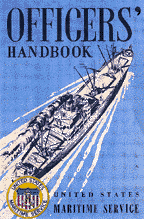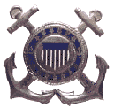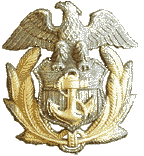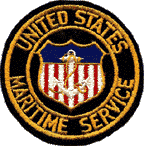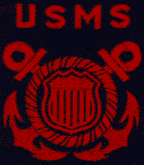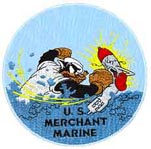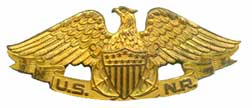PROPER DRESS
White or gray shirts are worn with blue dress uniforms.
Black shoes and black socks are worn with blue dress uniforms.
Blue or white cap covers (depending on "uniform of day") can
be worn with blue dress uniform.
Khaki shirts only with khaki work uniforms.
Black shoes and black socks or brown shoes and brown socks are worn with
khaki uniforms.
Khaki cap cover with khaki uniforms.
White shoes and white socks only with white dress uniforms.
Only white cap cover with white dress uniforms.
Black shoes and black socks, slate gray shirt, black tie and slate gray
cap cover are worn with slate gray uniform.
Uniform of the day for inactive officers of the U. S. Maritime Service
can be obtained usually from the Port Director's office or by telephone
call to the Enrolling Office. While aboard ship, this information can
be obtained from the Master.
As you know, shipboard dress is usually informal. However, the above rules
of dress should be strictly observed ashore.
OFFICERS' HANDBOOK: UNITED
STATES MARITIME SERVICE, WAR SHIPPING ADMINISTRATION, TRAINING ORGANIZATION
This pamphlet is issued to officers of the U. S. Maritime Service (active
and inactive) in order to acquaint them with the insignia and uniform
of the service.

A.B. Randall
Commandant
The Administration of the U.
S. Maritime Service is carried on by Merchant Marine officers who desire
most to see the personnel of the U. S. Merchant Marine receive the recognition
deserved by their splendid and outstanding performance of duty under hazardous
and arduous conditions. The U. S. Maritime Service is proud to offer these
officers its benefits. It asks only, in return, that its uniform and insignia
be worn with pride and that the conduct and bearing of the Officers wearing
it be in accordance with the accepted standard for officers.
Rank shown on your identification
card is the maximum that can be worn. Regardless of your position aboard
ship, while wearing U. S. Maritime Service insignia, it is unlawful to
wear rank other than shown on your current identification card. Attention
is also called to the fact that you should not wear the insignia of a
higher rank than called for by your position aboard ship, regardless of
your official designation.
CUSTOMS and ETIQUETTE of
the Service
The U. S. Maritime Service
is anxious to publish a book on customs and traditions of the U. S. Merchant
Marine. With this in view, the cooperation of the officers and men of
the U. S. Merchant Marine is requested. It is suggested that they send
into Headquarters, U. S. Maritime Service, Washington 25, D. C., any tradition
or custom which they believe should be incorporated in such a book, and
at the same time, if information is available, give in a few words the
origin of the custom. As you no doubt will realize, any Service or Corps
will be successful only if the members exhibit an enthusiastic interest
and cooperation. The Service expects and desires these things from each
member and suggestions for the improvement of the Service are enthusiastically
welcomed. The Service is administered by Merchant Marine officers and
the Service is anxious to be of assistance to the personnel of the U.
S. Merchant Marine.
The United States Maritime
Service as an organization is a comparative newcomer, particularly when
compared to the Army and Navy. However, the background of the profession
from which the members of the Maritime Service are drawn and for which
they are trained is as old, as historic, as full of the traditions of
heroism and honest service to the Nation as any service and, on that score,
the Merchant Marine which includes the Maritime Service needs apologize
to no one.
The Maritime Service, as such,
was established in 1938 and administered under the direction of the Maritime
Commission. As a new project it was necessary to do a great deal of experimentation
and to move slowly and cautiously. Until the onset of the war (and this
onset was, for the Merchant Marine, prior to Pearl Harbor) the training
was largely concentrated on men already in the industry. The sinking of
merchant vessels and the rapid expansion of shipbuilding facilities necessitated
a shift of emphasis to provide the new men and officers for the fleet.
From its establishment to January 1, 1944, the Maritime Service gave training
to 71,087 men.
On July 11, 1942, Executive
Order No. 9198 was signed by the President, transferring all Merchant
Marine training functions to the War Shipping Administration. The War
Shipping Administration accepted responsibility on September 1, 1942,
and assistance was provided by the Navy in ordering to key Maritime Service
positions a number of Merchant Marine officers on active duty with the
Navy.
On January 7, 1943, the Administrator
of the War Shipping Administration approved Supplement No. 1 to General
Order 23 which provided for the enrollment in the Maritime Service on
inactive duty of those officers of the Merchant Marine who desired to
wear the uniform of a recognized statutory Government Service. Without
much publicity except by word of mouth among the ships, 20,863 officers
have been commissioned to January 31, 1944. This number constitutes over
60 percent of the active officers of the United States Merchant Marine
with the number rapidly growing.
The Maritime Service exists
only because of and for its members. It is hoped that every officer will
take upon himself responsibility for the development of that esprit de
corps which is the common factor of pride binding all members of any service
together. An organization with a high degree of that common spirit cannot
fail. Without it, success is doubtful. It must be a part of the
duties of each Maritime Service officer to develop within himself that
feeling of common pride in his own service and to work toward a development
of the Maritime Service. If each officer does so, then the Service, which
exists for the benefit of the personnel of the United States Merchant
Marine, will steadily and surely rise in value and prestige and in that
rise carry with it its membership.
COMMISSION in the U. S.
Maritime Service
Present yourself at
the nearest Maritime Service Enrolling Office with the following documentary
evidence qualifying you for a commission:
(a) License. In the
case of members of the Staff Department (Purser and Medical) present
certificate of registry as Staff Officer. Steward Department officers
present certificate of service issued or endorsed as Chief Steward (F.
H.) Radio officers present license issued by F. C. C.
(b) Valid certificates of discharge or continuous discharge book or,
(c) Letter from a recognized official in the company or companies for
which you have been working for the past year of licensed service (or
all licensed service if less than one year) substantiating your sea
service, stating capacities served in and the names of ships.
(d) State Department Seaman's Passport or,
(e) Birth certificate. Presented by stewards and radio operators if
certificate or license does not show birth date.
The Enrolling Officer must
certify to the dates contained on your license and it is, therefore, necessary
that he see it.
You will be given a physical
examination conducted by an officer of the U. S. Public Health Service
attached to a Maritime Service Enrolling Office or training unit. The
physical standards prescribed for the Maritime Service shall be the same
as those prescribed for the license held. Defects considered not to be
sufficient to disqualify an officer from the performance of the duties
of his rank may be waived by the Commandant. Due consideration
will be given age and the type of duty to be performed.
The application, with accompanying
papers, will be forwarded to Maritime Service Headquarters, acted upon
promptly and, if accepted, your appointment will be forwarded to you via
the Enrolling Office through which you applied, or through any Enrolling
Office you indicate. This procedure is believed to be as simple and as
free from "red tape" as possible.
Any questions or inquiries regarding promotions should be brought to the
attention of the Enrolling Officer. If you are eligible for promotion
to a new rank do not delay in applying for it.
Sources:
Officers' Handbook: United States Maritime Service War Shipping Administration
1944
The National Geographic Magazine, December 1943
Disney Emblem contributed by Mark Gleeson of Pennsylvania

United
States Maritime Service
Disney Merchant Marine emblem
Home
3/17/02
www.USMM.org ©1998
- 2002. You may quote material on this web page as long as you cite American
Merchant Marine at War, www.usmm.org as the source. You may not use more
than a few lines without permission. If you see substantial portions of
this page on the Internet or in published material please notify usmm.org
@ comcast.net
